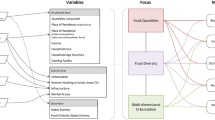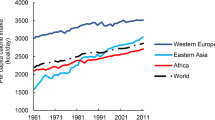Abstract
Depending on quantity and composition of food as well as on production conditions and techniques, the space needed to sustain an individual’s nourishment varies. The amount of space needed also depends on the use of resources such as energy, water, and fertilizers, as well as potential land degradation and water pollution. Our study focuses on the changing spatial imprint of an average inhabitant of an expanding Swedish city, Linköping, from 1870 to 2000 taking into account both shifts in consumption as well as agricultural productivity and practices. Despite the distinctly larger amount of animal food products, such as meat and fish, consumed in 2000, we calculate the area needed to sustain an individual’s annual food consumption could be less than one fourth of that needed in 1870. However, if the import of various globally produced foods is included in our calculations, the land needed to sustain the consumption of an inhabitant of Linköping in 2000 doubles. We also argue that an examination of this regional imprint can be used to explore and evaluate possibilities for regional development.
Similar content being viewed by others
References
Brown, L. (1999). Feeding 9 billion. In Brown, L. (ed.), State of the World 1999, Earthscan, London.
Carlsson-Kanyama, A., and Faist, M. (2000). Energy use in the food sector: A data survey. AFR-report 291. AFR, NaturvÅardsverket, Stockholm.
Cuss’o, X., Garrabou, R., and Tello, E. (2003). Energy flows, land use and landscape change in an organic advanced agriculture: The Catalan Vallès County in 1860/70. In Jelecek, L. et al. (eds.), Proceedings of the 2nd International Conference of the European Society for Environmental History on Dealing with Diversity. Charles University of Prague, Czech Republic.
Erb, K.-H. (2004). Actual land demand of Austria 1926–2000: A variation on ecological footprint assessments. Land Use Policy 21(3): 247–259.
FAO (1996). In-depth study: Patterns of marine fishery landings and future prospects. In Chronicles of Marine Fishery Landings (1950–1995): Trend Analysis and Fisheries Potential. FAO Fisheries Technical Paper No 359, by Grainger, R. J. R. and Garcia, S. M., Rome.
Haberl, H., Erb, K.-H., and Krausmann, F. (2001). How to calculate and interpret ecological footprints for long periods of time: The case of Austria 1926–1995. Ecological Economics 38: 25–45.
Hakanen, M. (1999). Yhdyskuntien ekologisesti kest¨av¨an kehityksen arviointi, kriteerit ja mittaaminen. PhD Thesis, Helsinki University, Finland.
Harris, J. M., and Kennedy, S. (1999). Carrying capacity in agriculture: Global and regional issues. Ecological Economics 29: 443–461.
¨(HÅO) Hush¨allningss¨allskapet¨Osterg¨otlands l¨ans handlingar, 1869–1951.
Krausmann, F. (2004). Milk, manure and muscular power. Livestock and the transformation of preindustrial agriculture in Central Europe. Human Ecology: An Interdisciplinary Journal 32(6): 735–772.
Lewan, L. (2002). Ecological footprints and biocapacity: tools in planning and monitoring of sustainable development in an international perspective. Report no 5205 pdf, Swedish Environmental Protection Agency, Stockholm.
LinkÅopings Kommun (2003). StatistiskÅarsbok 2003. Link¨opings Kommun, Link¨oping, Sweden.
LinnÁer, B.-O. (2003). The Return of Malthus, The White Horse Press, Isle of Harris, UK.
Meadows, D. H., Meadows, D. L., Randers, J., and Behrens, W. W. (1972). The Limits to Growth, Universe Books, New York.
Monfreda, C., Wackernagel, M., and Deumling, D. (2004). Establishing national natural capital accounts based on detailed Ecological Footprint and biological capacity assessments. Land Use Policy 21(3): 231–246.
Morell, M. (1989). Studier i den svenska livsmedelskonsumtionens historia, PhD Thesis, Almqvist & Wiksell International, Stockholm.
Morell, M. (2001). Jordbruket i Industrisamh¨allet, 1870–1945. Natur och Kultur/LTs F¨orlag, Stockholm.
NaturvÅardsverket (1997). Det framtida jordbruket: slutrapport frÅan systemstudien fÅor ett milj¨oanpassat och uthÅalligt jordbruk. Rapport 4755, Naturvardsverket, Stockholm.
Neset, T.-S. S. (2004). Reconstructing Swedish food consumption from 1870 onwards. Ecology of Food and Nutrition 43(3): 149–179.
Neset, T.-S. S. (in press). Environmental Imprint of Human Food Consumption–-Link¨oping, Sweden 1870–2000. Thesis. Link¨oping Studies in Arts and Science. Link¨oping University.
Norin, S. (1963). Data f¨or gÅardens Driftsplanering. LTs f¨orlag, Stockholm.
Palmer, A. R. (1998). Evaluating ecological footprints. Electronic Green Journal, December 1998, Special Issue 9.
Pfister, F. (2003). Resource Potentials and Limitations of a Nicaraguan Agricultural Region. PhD Thesis ETHZ Nr. 15169. Eidgen¨ossische Technische Hochschule Z¨urich, Switzerland.
Piementel, D., and Houser, J. (1997). Water resources: agriculture, the environment, and society. BioScience 47(2): 97–106.
Raab, B., and Vedin, H. (eds.) (1995). National atlas of Sweden; Climate, lakes and rivers, Almkvist & Wiksell International, Stockholm.
SCB (2001). Hektarsk¨ordar och totalsk¨ordar 2000. SOS/Statistiska meddelanden, JO 16 SM 0101 (pdf) http://www.sjv.se
SCB (2002). Jordbruksstatistisk ÅArsbok 2003. SCB, Stockholm.
SJV (2000). Totalkonsumtionen av livsmedel och dess n¨aringsinnehÅall.(Rapport 2000:16), Jordbruksverket, J¨onk¨oping.
SLU (1996). Databok f¨or driftsplanering. Speciella skrifter 62. Sveriges Lantbruksuniversitet, Uppsala.
Sch¨ule, H. (1989). Raum - zeitliche Modelle - ein neuer methodischer Ansatz in der Agrargeschichte. University of Bern, Switzerland.
Sustainable Sonoma County with Redefining Progress (2002). Time to Lighten Up? Report on the Sonoma County Footprint Project, Sustainable Sonoma County, Sebastopol, CA. (http://www.sustainablesonoma.org/projects/scefootprint.html).
UN Statistics (database). World Population Prospects: The 2004 Revision and World Urbanization Prospects: The 2003 Revision. Population Division of the Department of Economic and Social Affairs of the United Nations Secretariat. http://esa.un.org/unpp.
Wackernagel, M., and Rees, W. E. (1996). Our ecological footprint: Reducing human impact on the earth, New Society Publishers, Philadelphia, USA.
Wackernagel, M., Monfreda, C., and Deumling, D. (2002). Ecological Footprint of Nations–-November 2002 update–How Much Nature Do they Use? How Much do they Have? (pdf) www.ReefiningProgress.org.
Wackernagel, M., Lewan, L., and Borgstr¨om, H. (spreadsheet). Calculation of the Ecological Footprint (⋯) http://www.biol.lu.se/zoofysiol/Lewan/ef-swe94.pdf.
Wackernagel, M., Monfreda, C., Schulz, N. B., Erb, K.-H., Haberl, H., and Krausmann, F. (2004a). Calculating national and global ecological footprint time series: resolving conceptual challenges. Land Use Policy 21(3): 271–278.
Wackernagel, M. Monfreda, C., Erb, K.-H., Haberl, H., and Schulz, N. (2004b). Ecological footprint time series of Austria, the Philippines, and South Korea for 1961–1999: Comparing the conventional approach to and ‘actual land area’ approach. Land Use Policy 21(3): 261–269.
World Resources Institute (1998). World resources: A report by the World Resources Institute and the International Institute for Environment and Development. 1998/99, A guide to the global environment: Environmental change and human health. Basic Books, New York.
WWF. (2002). Living Planet Report 2002. WWF, Gland, Switzerland.
Author information
Authors and Affiliations
Corresponding author
Rights and permissions
About this article
Cite this article
Neset, TS.S., Lohm, U. Spatial Imprint of Food Consumption: A Historical Analysis for Sweden, 1870–2000. Hum Ecol 33, 565–580 (2005). https://doi.org/10.1007/s10745-005-5160-3
Issue Date:
DOI: https://doi.org/10.1007/s10745-005-5160-3




